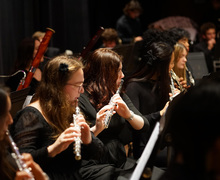Dozens of fire alarms set off by e-cigarettes, popcorn disturb the sleep of students living in Lawrinson Hall
Daily Orange File Photo
Only two of 244 fire alarms at SU in 2016 were due to an actual fire.
Way up on Lawrinson Hall floor 20, when it’s about 3 or 4 a.m., the fire alarms feel like a dream.
Chase Blessington, a Syracuse University freshman, is usually fast asleep. But when the alarm goes off, Blessington wakes up and sighs. She grabs her coat and makes the 20-floor walk downstairs.
“If one happens,” Blessington said, “you can almost guarantee another one is going to happen that night. We had one night with like four in a row.”
Some residents living on the top floor in the largest dormitory on campus consider themselves fire alarm veterans. Not by choice, but mostly because of perfume, popcorn, e-cigarettes, cigarettes and marijuana. Lawrinson had 36 fire alarms last semester, according to a bulletin board in the building’s lobby. Several residents said there were four in one night last semester.
Last year, DPS removed the microwaves on each floor of Lawrinson and consolidated them to a single area on the ground floor. The fire alarms have still not let up, displeasing students on the upper floors and thrusting into the spotlight the issue of student safety.
Many dread the 20-story walk down and ensuing 20-story walk back up, which they said can take up to an hour, when taking into account the 20 minutes spent waiting outside for the fire department to investigate the building. Several students said they have neighbors who do not always leave their rooms when the alarms go off.
There were 244 fire alarms in all SU residence halls in 2016, up from 177 alarms in 2015, according to the 2017 Public Safety Annual Report. Sixty percent of them were accidents, cooking-related or malicious, meaning tampering with any fire safety devices. DPS fire and life safety manager John Rossiter said many of the alarms occur between 10 p.m. and 6 a.m., and only two out of the 244 alarms in 2016 were set off because of an actual fire.
“The majority of the causes of fire alarms in resident halls originate in student rooms,” Rossiter said. “Various causes include air-freshener spray, burnt food from microwave, smoke. That has the potential to activate the entire building for evacuation.”
The Syracuse Fire Department, which works alongside DPS, does not receive compensation for trips to the university, regardless of the number. Whether there are three fire alarms in one night or just one per week, the department will answer all calls without pay. But the more frequent the fire alarms are at SU, the more local fire departments’ resources are pulled from other areas of the city, Syracuse Fire Department Deputy Chief Paul Cousins said.
In 1999, the university implemented a five-year, $12 million plan to retrofit all residence halls with sprinkler systems. Smoke detectors are checked individually each year. About two weeks ago, New York state finished its inspection of all campus dorms, which started in September. All pipes inside the sprinkler system are inspected with a camera to ensure there is no debris.
The detectors on campus are designed to detect smoke and fire in their early stages and alert people so they can exit the area. Technological advances have, in general, made smoke detectors more sensitive, said Wayne Sandford, a professor of fire science and professional studies at the University of New Haven. He said increased-sensitivity among detectors likely will continue, meaning there will be more alarms set off in coming years.
“With the new detectors, we’ll see them be much faster acting than the current detectors,” said Sandford, a former deputy commissioner of emergency management and homeland security for the State of Connecticut. “Technology’s going to make them much faster responding when there’s smoke or even an odor.”
Sandford and Rossiter said dorms with all or mostly freshman students have more fire alarms. Nationwide, popcorn is the “No. 1 offender,” Sandford said, but the reasons why there are more alarms in freshman dorms runs deeper. Many students in their first year of college have little to no experience living on their own. He said these students haven’t had to worry much about fire safety all of their lives, and that an increased focus on training from an earlier age would help.
Each dorm is required to have two fire drills per semester and each academic or administrative building is required to have three per calendar year.
Sylvia Probst, a Lawrinson resident living on the 20th floor, said fewer and fewer students seem to be leaving the building for fire alarms as the year goes on. During some fire alarms, only about 50 of about 540 residents leave the building, Probst said.
“For the first fire alarm, everyone went down,” Probst said. “By now, you can see the number is dwindling.”
Jack Levy, a freshman in the College of Arts and Sciences living on the top floor of Lawrinson, recalls that his resident adviser said to always evacuate the building. That’s because the penalty of getting caught is not worth it. DPS has said it has begun checking rooms during fire alarms, and students found in their room may not be able to rush or hold an e-board position on campus, according to a bulletin board in Lawrinson’s lobby. Levy said he goes down every time.
“Twenty flights of stairs is quite an exercise,” Levy said. “I use that as my gym time.”
Published on February 14, 2018 at 10:33 pm
Contact Matthew: mguti100@syr.edu | @MatthewGut21





